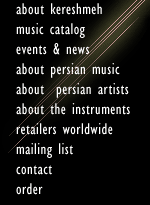


Hossein Alizadeh
on the Radif of
Persian Classical Music
The classical music of Iran is based on the Radif, which is a collection of old melodies that have been handed down by the masters to the students through the generations. Over time, each master's own interpretation has shaped and added new melodies to this collection, which may bear the master's name. The preservation of these melodies greatly depended on each successive generations' memory and mastery, since the interpretive origin of this music was expressed only through the oral tradition. To truly learn and absorb the essence of the Radif, many years of repetition and practice are required. A master of the Radif must internalize the Radif so completely to be able to perform any part of it at any given time.
The Radif contains several different maqam's which are distinguished from each other by their relationship of note intervals and the form of the movement of the melodies within them. A maqam portrays a specific sonic space. A dastgah may contain approximately from 10 to 30 gousheh's (melodies). The principle gousheh's of the dastgah specify the different maqams within that dastgah. The note, upon which the gousheh is based and often is the center of the gousheh, is called the shahead. The shahead moves when we modulate between principle gousheh's, and this movement creates a new sonic space. Rhythm in these melodies takes three different forms: symmetric, asymmetric(lang), and free form. The rhythm is greatly influenced by the rhythm and meter of the Persian poetry. The instrumental and vocal Radif are different from the rhythmical point of view; however, their melodic structures are the same. The name of the different dastgah's in the Radif are:
- Dastgah Shur,
- Avaz Abuata,
- Avaz Bayat Tork,
- Avaz Afshari,
- Avaz Dashti,
- Dastgah Segah,
- Dastgah Chahargah,
- Dastgah Homayoun,
- Avaz Esfahan,
- Dastgah Nava,
- Dastgah Mahur,
- Dastgah Rastpanjgah.
Excerpted from the liner notes of KCD-101 Hamnava'i.